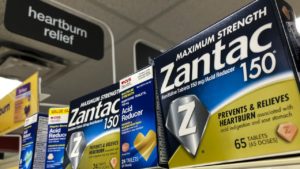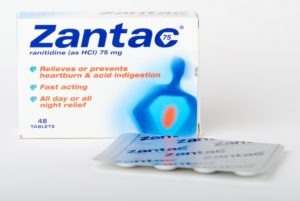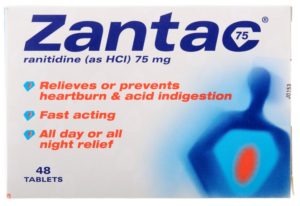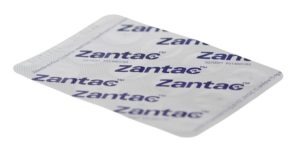Zantac/Ranitidine and the Dangers of NDMA Exposure
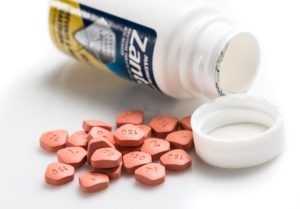
For most of us, it’s become common to watch advertisements for various medications and chuckle to ourselves as the spokesperson speeds through the possible side effects like an auctioneer who’s late for a date. The print is too small to be legible, and we often grimace as we imagine the seemingly harmless medication causing heart attack, death, or stroke.
But what about the side effects that aren’t stated? The one’s pharmaceutical manufacturers either don’t know about or negligently disregard? These are the most harmful– and the most illegal.
Such is the case with Zantac, the popular heartburn and stomach aid. In the last two years, studies have revealed that Zantac contains harmful amounts of N-nitrosodimethylamine, or NDMA, a chemical which is heavily suspected to cause cancer. As manufacturers scramble to pull the drug off the shelves, it’s important for its users to fully understand the risks they’ve been subjected to, and how to best navigate legal action.
What is Zantac and What is it Prescribed For?
For a free legal consultation, call (725) 900-9000
Zantac is a prescription drug that is used to treat discomfort from heartburn and other stomach-related issues. Its active ingredient is ranitidine, which is sold as a generic over-the-counter alternative, and is found in other medications as well. Ranitidine products (including Zantac) are most commonly used to treat the following:
- Stomach ulcers
- Gastroesophageal reflux disease, a condition in which the backward flow of stomach acid affects the esophagus
- Other conditions where too much stomach acid is being produced, such as Zollinger-Ellison Syndrome.
Ranitidine-based medications belong to a class of drugs known as H2 (histamine-2) blockers. Histamine is a naturally occurring chemical that stimulates the cells in your stomach to start producing acid; thus, the application of the medication works to block the action of the histamine and help reduce the production of stomach acid.
Click to contact our personal injury lawyers today
The original brand-name drug Zantac was initially developed by Glaxo Holdings Ltd, and was approved in the US by the FDA in 1983. In only five years’ time, the drug had surpassed $1 billion in annual sales, and had become one of the best-selling drugs in the world. In 1997, Glaxo’s US patent expired and competitors began launching over-the-counter ranitidine-based alternatives in the following years.
Zantac and Ranitidine Recalls: A Brief History
Complete a Free Case Evaluation form now
Up until about 2018, Zantac and other ranitidine medication had enjoyed a very successful and lucrative lifespan. However, things started to shift in July 2018 when the FDA announced a voluntary recall of a different substance– valsartan.
Preliminary testing of valsartan-based medication, which is primarily used to treat high blood pressure, had revealed trace amounts of N-nitrosodimethylamine, or NDMA. NDMA is classified as a Group 2A carcinogen by the International Agency for Research on Cancer, meaning that it is “probably carcinogenic to humans” based on animal and laboratory testing.
The reason why the discovery of NDMA in valsartan is important is because there are numerous medications that include both valsartan AND ranitidine. Many scientists and researchers believed that ranitidine products should undergo similar testing, and so new investigations began.
By late 2019, it appeared that the initial fears proved to be valid. On September 13th of that year, the FDA made another statement, this time to warn patients and health care professionals that “low levels” of NDMA had been discovered in ranitidine-based medicines including Zantac (whom they mentioned by name). It is important to note that at the time, the FDA was simply offering a warning and did not ask for recalls or any halt to production.
In the months that followed, the global Zantac and ranitidine market began to unravel, as manufacturers around the world halted production and recalled products. By the end of 2019 almost all pharmacies in the US had halted Zantac sales. Some manufacturers began to be hit with lawsuits as early as October.
By April 1st, 2020, after more thorough research and laboratory testing, the FDA finally brought the hammer down and officially requested the immediate recall of all ranitidine products (including Zantac) after it was confirmed that the amount of NDMA found in these medications was no longer safe for consumption.
NDMA: Causes and Effects
By now you may be thinking, ‘well, just what is NDMA and why is it dangerous?’ The latter half of that question is still a bit difficult to answer definitively– which, in some ways, makes these discoveries even more worrisome– but here’s what we know so far:
N-nitrosodimethylamine (NDMA) is a relatively simple chemical compound that is found in many different places, as it is a byproduct of several processes, from manufacturing to cooking. As a result, it can be found in soil, air, foods such as meats and vegetables, and water. Not so fun fact: it was also once used to make rocket fuel (!).
The existence of NDMA has long been known to science and health professionals; many agencies have already established amounts of the substance that are deemed safe for humans– for example, the FDA has set a mark of 0.096 micrograms per day as being safe for human consumption. The EPA has said that the acceptable threshold for NDMA in tap water is 0.11 micrograms per liter.
But what happens when we exceed those “safe” numbers? That’s precisely the problem that has led Zantac and other ranitidine medicines directly to the courthouse: the levels of NDMA that has been and continues to be found in these drugs is astronomically high.
The task of determining just how much NDMA is in Zantac and other ranitidine medications has proved to be quite the conundrum for researchers, and that doesn’t favor the drug. Different firms have studied different lots and gotten different results, but one thing is certain: every result is too high. One study that has been widely cited posted an average result of 0.86 micrograms of NDMA per ranitidine dose– that’s nearly ten times the allotted daily number!
The main reason for this variance is the fact that ranitidine is an inherently unstable drug, meaning the compounds will continuously break down over time. In the case of Zantac, this degradation directly produces NDMA; in other words, the longer it sits, the higher the NDMA levels.
Temperature is also a key factor– most drugs are not stored in optimal conditions year-round, and temperature variance also contributes to higher NDMA levels. Emery Pharma posted a study in which NDMA levels in ranitidine increased by 48 percent after exposure to high temperatures for just 12 days.
The direct effects of NDMA overexposure are varied, but there are a few commonalities. After long periods of ingesting large amounts of the chemical, the most common issues are related to the internal organs – a World Health Organization report cites liver and stomach cancer as the two main dangers, with additional defects to the bladder, spleen, lungs, and breast also possible.
Am I Eligible For a Lawsuit?
Anyone who has a history with Zantac or other ranitidine-based medications and is unsure about whether it’s caused any negative effects should consider the following symptoms:
- Reduced liver, kidney, and lung function
- Enlarged liver
- Stomach cramps
- Headaches and fever
- Vomiting and nausea
If a longtime Zantac or ranitidine user is diagnosed with a serious condition from liver failure to various cancers and a correlation is made between the condition and the use, he or she is certainly entitled to compensation. The victim or immediate family members are eligible to file a Wrongful Death or Personal Injury claim, but there are a few things one must keep in mind.
What Do I Need to Compile for a Case?
In order to build as strong of a case as possible, one must satisfy a few different criteria: first, proven Zantac use– usually at least 6 months to a year of steady use is necessary to show long-term effects. Next, a cancer diagnosis from a medical professional. Lastly, some kind of connection between the diagnosis and the drug’s effects is needed to prove liability on the manufacturer’s behalf. This is usually done through testimony and a review of the victim’s past medical history.
The defense will typically question the validity of these findings, such as the length and scale of drug use, the connection of the diagnosis to the drug use, and any other possible outliers, such as the victim’s personal or family medical history.
Possible Compensation
A successful Wrongful Death or Personal Injury claim can bring forth multiple kinds of compensation for the victim, such as lost wages and damage to future wages, medical reimbursement including prescription costs, and non-economic losses such as Loss of Enjoyment and Pain and Suffering.
If you or someone you know has a long history with Zantac or other ranitidine-based medications and is experiencing some of the symptoms mentioned above, please meet with a medical professional first to alleviate any immediate dangers. Then contact Van Law Firm at 725-900-9000 for a free consultation. Our attorneys are experienced in navigating these cases and we will fight on your behalf to get you the compensation you deserve.
No obligation consultations are always free.
Let Us Help You! Call Now: (725) 900-9000